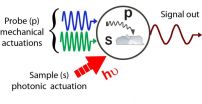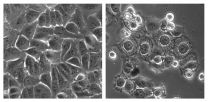(Press-News.org) Scientists at the Johns Hopkins Kimmel Cancer Center have identified a molecular partnership in pancreatic cancer cells that might help to explain how the disease spreads -- metastasizes -- in some cases. Their findings reveal urgently needed new targets to treat pancreatic cancer, which strikes nearly 50,000 people in the U.S. each year and has only a 5 percent survival rate five years after diagnosis.
One of the molecular partners is annexin A2, a protein that scientists say was already linked to poor survival rates in these cancers. In a report published in the Aug. 4 issue of Science Signaling, Lei Zheng, M.D., Ph.D., and his colleagues show that annexin A2 helps usher a protein called Sema3D out of pancreatic cancer cells. Once outside the cells, Sema3D joins with another molecule to fuel the cancer's spread. Sema3D is a protein that guides the projecting arms of nerve cells, called axons, as the nerve cells grow and develop.
In experiments with mice, the researchers calculated a seventyfold drop in the amount of Sema3D secreted from mouse pancreatic cancer cells in animals that lacked annexin A2. In an experiment involving 23 mice, none of the annexin-free animals developed visible metastatic tumors. By contrast, 16 out of 17 mice that produced annexin A2 in their cells developed metastatic tumors in the liver, lungs or abdominal cavity.
In a second group of experiments using human tissue from patients with pancreatic ductal adenocarcinoma, which accounts for more than 90 percent of pancreatic cancers, Zheng and his colleagues also tracked down a link between the abundance of Sema3D in those tissues and the progression of metastatic pancreatic cancer.
The team reports that Sema3D was abundant in the main tumor tissue of only three of 13 (23 percent) patients who died after minimal cancer spread. But it was abundant in the main tumors of 14 of 22 (64 percent) patients who died with widely metastatic cancer, and also in the metastatic tumors of 17 of 23 (74 percent) patients.
The presence of Sema3D also seems to be associated with the recurrence of pancreatic cancer in patients whose primary tumors were surgically removed, the scientists say. Sema3D was abundant in the primary tumors of 15 of 20 patients (75 percent) who lived free of the cancer for less than a year after their surgery, compared to only four of 15 (27 percent) patients who lived disease-free for more than two years after surgery.
With their new data in hand, the researchers are pursuing three possible therapeutic targets to stop pancreatic cancer metastasis driven by annexin A2 and Sema3D. "We are planning clinical trials with a recently developed vaccine to target annexin A2," says Zheng, an associate professor of oncology and surgery at the Johns Hopkins University School of Medicine. "But at the same time, we are also developing a therapeutic antibody targeting annexin A2, and we are looking for a small molecule that would inhibit Sema3D."
Zheng and colleagues emphasize they don't know precisely how the Sema3D encourages the spread of pancreatic cancer, but they think it may help cancer cells surround and track nerves to travel away from the main tumor.
This neural highway might be especially important in pancreatic cancer, they say, because it grows fewer blood vessels that can carry cancer cells to the rest of the body. "More so than some other cancers, pancreatic cancers are what we call neurotropic, meaning that they tend to invade nerves," explains Zheng.
It's also unclear at this point, he says, exactly how annexin A2 encourages pancreatic cancer cells to release Sema3D, but the researchers suspect annexin A2 may act like a bodyguard to Sema3D, sheltering and guiding the protein as it makes its way toward an exit at the cell surface. Or, they speculate, it may act more like a professional packer, helping to enclose Sema3D in tiny molecular bubbles called vesicles before it is secreted by the cell.
Zheng and his colleagues became interested in annexin A2's exact role in cancer spread after noting a curious effect in a trial of the pancreatic cancer vaccine GVAX, first developed by Johns Hopkins researchers.
In a 2011 vaccine trial of patients whose primary pancreatic tumors were surgically removed, "we found antibodies against annexin A2 in those who had received the vaccine and who also had demonstrated long-term, disease-free survival after receiving the vaccines," explains Zheng. "This suggested to us that we should study annexin's role in pancreatic cancer progression."
The research was supported by the National Institutes of Health's National Cancer Institute (R01 CA169702, K23 CA148964-01, HL42093, MOD FY15-226, P50 CA062924, P30 CA006973), the Viragh Foundation and the Skip Viragh Pancreatic Cancer Center at Johns Hopkins, the Lefkofsky Family Foundation, and a Lustgarten Foundation grant.
Jaffee and Zheng hold a patent on annexin A2 as a target for cancer therapy, and Zheng has a pending patent on annexin A2 as an immunological target (U.S. Patent Application No. 14/249,534).
INFORMATION:
Other Johns Hopkins scientists who contributed to the research include Kelly Foley, Agnieszka A. Rucki, Qian Xiao, Donger Zhou, Ashley Leubner, Guanglan Mo, Jennifer Kleponis, Annie A. Wu, Rajni Sharma, Qingguang Jiang, Robert A. Anders, Christine A. Iacobuzio-Donahue, Anirban Maitra and Elizabeth M. Jaffee; and Katherine A. Hajjar of Weill Cornell Medical College.
(Broadcast-quality video and infographics available with this story)
ANN ARBOR, Mich. -- With more kids online and using cell phones at increasingly younger ages, two issues have quickly climbed higher on the public's list of major health concerns for children across the U.S: sexting and Internet safety.
Compared with 2014, Internet safety rose from the eighth to the fourth biggest problem, ahead of school violence and smoking, in the 2015 annual survey of top children's health concerns conducted by the C.S. Mott Children's Hospital National Poll on Children's ...
OAK RIDGE, Tenn., Aug. 10, 2015 - A microscope being developed at the Department of Energy's Oak Ridge National Laboratory will allow scientists studying biological and synthetic materials to simultaneously observe chemical and physical properties on and beneath the surface.
The Hybrid Photonic Mode-Synthesizing Atomic Force Microscope is unique, according to principal investigator Ali Passian of ORNL's Quantum Information System group. As a hybrid, the instrument, described in a paper published in Nature Nanotechnology, combines the disciplines of nanospectroscopy and ...
In emerging economies, where real estate is expensive and space is limited, there has been a boom in multiplex movie theater construction fueled by the conviction that small screens with many show times will increase ticket sales. But new research from the University of Chicago Booth School of Business finds that the strategy doesn't always work.
In the paper Quality vs. Variety: Trading Larger Screens for More Shows in the Era of Digital Cinema by Chicago Booth Assistant Professor of Marketing Anita Rao and Stanford University Professor Wesley R. Hartmann, researchers ...
A drug candidate that overstimulates proteins crucial for tumor growth shows promise as a new strategy to treat a wide range of cancers. The demands of rapid cell division put a strain on cancer cells, and the approach works by tipping cell stress over the edge. In the August 10 issue of Cancer Cell, American researchers show that the drug candidate inhibits tumor growth in a mouse model of breast cancer and efficiently kills a broad range of human cancer cells.
"No prior drug has been previously developed or proposed that actually stimulates an oncogene to promote therapy," ...
Low-income people who struggle to put food on the table also use the health care system more, which means higher health care costs, according to new research published in CMAJ (Canadian Medical Association Journal).
"We know that people who have trouble affording the food they need have poorer health in general as well as more chronic disease," states Dr. Valerie Tarasuk, Department of Nutritional Sciences, University of Toronto, Toronto, Ontario.
The term "food insecurity" describes inadequate or insecure access to food because of financial constraints. In Canada in ...
As California wildfires burn tree canopies and the forest floors they support, the plants that are replacing the understory are increasingly those found in more southern areas of the West, according to a study from the University of California, Davis.
"The plants we're finding underneath our forests are becoming more like those seen in Mexico and Southern California," said lead author Jens Stevens, a postdoctoral scholar with the UC Davis John Muir Institute of the Environment. "Under climate change, we're seeing species from drier, warmer areas increasingly taking over. ...
BOSTON-The term "transgender" has made its way into mainstream media thanks to Caitlyn Jenner, previously known as Bruce Jenner, who came out as a transgender woman earlier this year. But for many physicians, or physicians-in-training, who do not typically treat transgender patients for issues specific to their gender identity, it's still a mystery.
Joshua Safer, MD, FACP, endocrinologist at Boston Medical Center and associate professor of medicine and molecular medicine at Boston University School of Medicine (BUSM), and his colleague Dylan Thomas, MD, conducted an ...
Taking four pain pills an hour instead of four pills a day
Need improved, understandable discharge instructions
More than 9 million ambulatory surgeries performed annually on seniors
CHICAGO --- Patients 65 and older who have ambulatory surgery are much more likely to be readmitted to the hospital within 30 days than younger patients, regardless of their health before surgery, reports a new, large national Northwestern Medicine study. The likely cause, based on previous research, is difficulty understanding medication dosing and discharge instructions, as well ...
Results of a 2013 DREAM Challenge - a crowdsourcing initiative for systems biomedicine - have been published in Nature Biotechnology;
Hundreds of scientists from around the world pooled their efforts to test how accurately they could predict the effect of toxic compounds in different individuals, or across a population;
Combined results achieved a rough estimate of population effects, and methods emerged that may be able to provide real-world benefit in the hazard assessments of new compounds.
10 August 2015 - An international study published in Nature Biotechnology ...
Widespread drought-sensitive butterfly population extinctions could occur in the UK as early as 2050 according to a new study published today in the scientific journal Nature Climate Change.
However, the authors conclude that substantial greenhouse gas emission reductions combined with better management of landscapes, in particular reducing habitat fragmentation, will greatly improve the chances of drought-sensitive butterflies flying until at least 2100.
The study was led by Dr Tom Oliver from the UK's Centre for Ecology & Hydrology (CEH) in collaboration with colleagues ...



